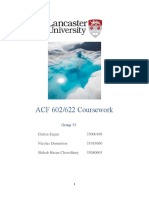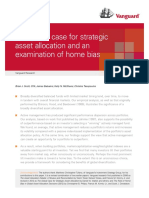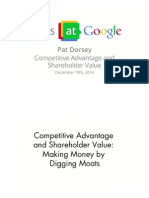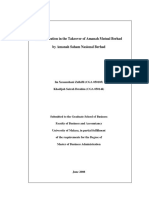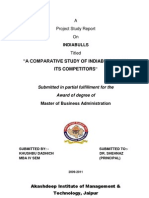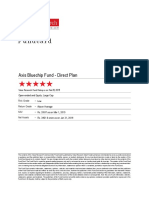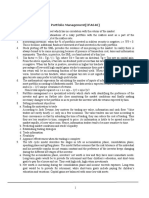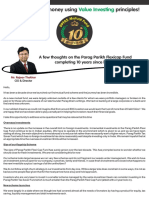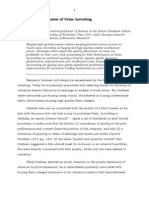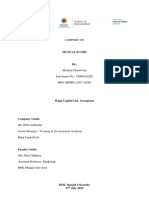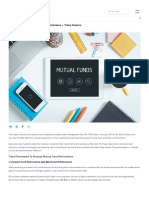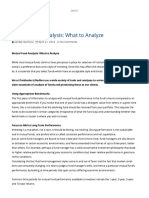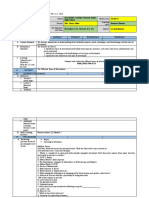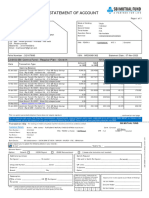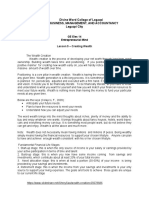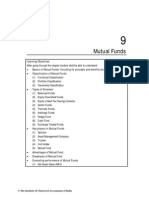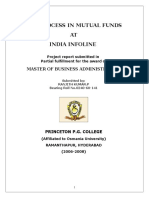Performance Analysis of Mutual Funds:
Conduct indepth analysis of mutual fund performance, comparing it against benchmarks and peer fu
nds to provide insights for investors.
Objective
The objective of this project is to conduct a comprehensive analysis of mutual fund performance in t
he Indian market, comparing it against relevant benchmarks and peer funds to provide valuable insig
hts for investors.
Scope of Work
1. Data Collection: Gather historical performance data of selected mutual funds, including Net
Asset Value (NAV), returns, expense ratios, and other relevant metrics.
2. Benchmark Selection: Identify appropriate benchmarks for each mutual fund category (e.g.,
Nifty 50 for large-cap equity funds, Nifty 100 for mid-cap equity funds).
3. Performance Metrics Calculation: Calculate key performance metrics such as Alpha, Beta, Sh
arpe Ratio, Treynor Ratio for each mutual fund.
4. Comparative Analysis: Compare the performance of each mutual fund against its benchmark
and peer funds using the calculated metrics.
5. Insight Generation: Provide insights and recommendations based on the analysis, highlightin
g top-performing funds, underperforming funds, and potential investment opportunities.
6. Report Preparation: Prepare a detailed report summarizing the findings, including visual aids
like charts and graphs to illustrate the performance comparisons.
Tools: Used financial analysis software (e.g., Bloomberg, Morningstar), data visualization tool
s (e.g., Tableau, Power BI)
Performance analysis of a mutual fund involves evaluating various metrics and qualitative
factors to determine how well the fund has met its investment objectives. Here are the key
aspects to consider:
1. *Returns Analysis*
- *Absolute Returns*: Assess the fund’s overall return over specific periods (1-year, 3-year, 5-
year).
- *Annualized Returns*: Calculate average returns per year over a defined period.
- *Benchmark Comparison*: Compare the fund's performance against a relevant benchmark
index (e.g., S&P 500, Nifty 50).
2. *Risk Assessment*
- *Standard Deviation*: Measure the volatility of the fund's returns; higher standard
deviation indicates higher risk.
�- *Beta*: Evaluate the fund’s sensitivity to market movements. A beta greater than 1
indicates more volatility than the market.
- *Sharpe Ratio*: Calculate the risk-adjusted return. A higher Sharpe ratio indicates better
risk-adjusted performance.
3. *Expense Ratio*
- Analyze the fund's expense ratio, which includes management fees and operating expenses.
Lower expense ratios are generally preferable as they leave more returns for investors.
4. *Portfolio Composition*
- Review the fund's asset allocation (stocks, bonds, cash) and sector exposure. This helps in
understanding the fund's strategy and risk profile.
- Examine the concentration of holdings; a well-diversified portfolio can mitigate risk.
5. *Management Quality*
- Research the fund manager's track record, experience, and investment philosophy. A skilled
manager can significantly impact performance.
6. *Historical Performance Trends*
- Look for consistency in performance across different market cycles (bull and bear markets).
- Identify if the fund consistently meets or exceeds its benchmarks.
7. *Investor Sentiment and Flows*
- Monitor net inflows or outflows from the fund. Significant outflows may indicate
dissatisfaction with performance or market conditions.
8. Fund Size and Liquidity
- Consider the fund's size (assets under management). Very large funds may face challenges
in maintaining performance due to difficulties in executing trades efficiently.
9. Tax Efficiency
- Evaluate the fund's tax implications, such as capital gains distributions, which can affect
investor returns.
� Conclusion
A comprehensive performance analysis of a mutual fund requires looking beyond just
returns. It’s essential to consider risk, fees, management, and how the fund aligns with your
investment goals. Regular monitoring is key to ensuring the fund continues to meet
expectations.
6 Parameters to Analyze Whether a Mutual Fund is Right for You
1. Expense Ratio
The expense ratio is the percentage of total assets that a mutual fund charges an investor
annually for managing their money.
The expenses related to Mutual Funds fall into 5 categories-
Distribution charges
Security transaction fees
Management fee
Investors transaction fee
Fund service charges
Basically, the expense ratio reduces the returns available to the investor. Therefore, an
investor should look for funds with a lower expense ratio.
You must be thinking – how does the expense ratio of a scheme affect the returns?
Mutual fund schemes are usually categorized into – Direct and Regular Plans.
Both these plans are exactly the same, as they are run by the same fund managers. The
funds in both the plans are invested in the same stocks and bonds, making the portfolio
essentially the same.
The difference lies in the fact that direct mutual funds charge no broker/distributor
commission and other charges.
On the other hand, regular mutual fund schemes charge broker or intermediary fees or
commissions. This is because usually mutual funds are sold through brokers and
intermediaries.
�This commission is added to the expense ratio of the fund making it more expensive than the
direct plan. The commission usually amounts to 1% – 1.25% per year. The difference can be
observed in the NAV and returns of the 2 plans.
Therefore, investors must compare the expense ratios of the various funds before investing
in one. Obviously, the fund with the lower expense ratio is preferred
2. Fund Performance vs Benchmark Performance
So this is one of the first things most investors check for in a scheme.
However, what percentage return indicates a good performance? How do you know whether
your selected fund has performed well or not?
The performance of a particular fund must always be compared with the performance of the
respective benchmark for the fund. Each and every scheme necessarily has a benchmark,
which it aims to outperform.
To understand this point, let us take the help of an example.
Let us assume that you invested in a particular mutual fund scheme. After a year, the total
returns provided by the scheme are 20%.
You must be thinking that the return looks pretty decent, right?
Not necessarily.
As you might have heard, a popular saying goes- ‘The devil is in the details.’
Now, what if I tell you that during the one year in concern, the benchmark for the particular
fund generated a return of 25%.
Now, did your fund perform better or worse as compared to the benchmark?
Yes, you got it right. If you would have simply invested in the benchmark index, you would
have made 25%. Whereas, upon investing in the concerned fund, you made 5% less.
If a fund generates excess returns over the returns of the benchmark, then the quantum of
excess returns is referred to as the fund’s alpha.
Therefore, the moral of the story is, it is always advisable to compare the returns of a
particular fund against its benchmark index. Investors must always look for positive alpha in
a fund.
If the concerned fund has consistently outperformed the benchmark index, then you tick this
particular checkbox.
3. Risk Level
Checking for the risk level of a scheme is as important, if not more, as checking for returns.
In the world of mutual funds, risk and returns are 2 sides of the same coin.
There is a very important reason, why each scheme discloses its risk level. The risk is defined
so that the investor is aware of how much risk the particular investment entail.
�Usually, the risk is defined with the help of the following 5 categories- low, moderately low,
moderate, moderately high and high.
Are you thinking, what do we do with the given risk level of a particular scheme?
The simple answer is, that the risk should fall within your risk appetite. If you are an investor
with a low or moderately low-risk appetite, then you should avoid high-risk funds
Moreover, you must also check for risk-adjusted returns. If the fund has a higher risk level,
then it only makes sense to invest in that fund if it gives higher returns sufficient to
commensurate with the risk.
4. Fund’s History
The real test for a mutual fund is its long-term performance.
A good fund is one which has generated consistent and stable returns over a period of 5-10
years.
The fund will usually see at least one down business cycle. This gives the investors
confidence that the fund can deliver returns, not only in the bull cycle but the bear cycle as
well.
To understand this, let us take the help of an example.
Example 1:
Suppose a fund generates a return of 12% in the previous year but did not do too well in the
preceding previous years.
But looking at the good performance of last year, you decided to invest in the scheme.
However, going forward, in the next year, the markets performed poorly. Markets registered
a loss of 5%. However, the fund registered a loss of 9%.
Now, the investor would find himself/herself in a fix.
The moral of the story is that an investor should look at the history of the fund. Specifically,
the performance of a fund over a period of at least 5 years.
5. Portfolio Turnover Ratio
Portfolio Turnover Ratio tells you how frequently the fund manager buys/sells securities from
the fund.
You may wonder, why is that relevant to you?
It is important to you because the higher the portfolio turnover ratio, the higher the
buying/selling of security. This, in turn, would attract higher transaction charges in the form
of brokerages and other fees.
A portfolio turnover ratio, thus, reduces your net returns from the investments.
Investors can use these two to calculate the net take-home return and compare funds.
Example 1:
There are 2 funds in consideration. Let’s call them to fund A and fund B respectively.
�The returns for them are 10% and 9% respectively. Given this limited information, it seems
like fund A is a better choice.
Now, the expense ratio for the 2 funds is 3% and 1% respectively. This changes the equation,
a little bit.
The net returns from fund A and fund B are 7% and 8% respectively. Given this information,
fund B becomes preferable.
All in all, while analyzing a mutual fund scheme, it is a good idea to have a look at the
portfolio turnover ratio, along with the expense ratio.
6. Fund Manager
Apart from the above-mentioned points, there are some other aspects which can also be
looked upon.
The performance and history of the fund manager are crucial.
An investor can look at the experience that the fund manager has, other schemes that the
fund manager is managing and so on.
This increases the reliability and confidence that your hard-earned money is in safe hands.
Moreover, the reputation and history of the fund house, under which the scheme belongs
can also be looked upon.
Conclusion
Knowing what to look at while evaluating a mutual fund, leads to the selection of a good
mutual fund. This knowledge can go a long way in helping you make the correct investment.
It must always be kept in mind that investment in mutual funds is subject to market risks.
Therefore, proper due diligence is beneficial.
To look at some of the best-performing funds from every category of mutual funds, check
out Groww 30: Top funds in every mutual fund category.





